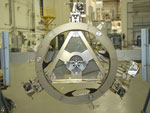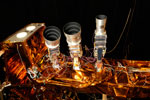|
NASA engineers have known for years that Hubble will need to be safely de-orbited at the end of its mission life. Originally planned for Earth return on the Shuttle, Hubble's scientific life will now extend to 2013, beyond the planned retirement date of the Shuttle in 2010.
Engineers have developed the Soft Capture and Rendezvous System, or SCRS, which will enable the future rendezvous, capture, and safe disposal of Hubble by either a crewed or robotic mission. The SCRS is comprised of the Soft Capture Mechanism (SCM) system and the Relative Navigation System (RNS).
Soft Capture Mechanism
 In order to accommodate a "next generation space transportation vehicle," astronauts will install a Soft Capture Mechanism (SCM) to Hubble's aft bulkhead. This ring-like device will permit Hubble to be docked to a future vehicle, as well as to accept a propulsion module for a controlled and safe eventual de-orbit of the observatory. It provides a Low Impact Docking System (LIDS) interface and associated relative navigation targets for future rendezvous, capture, and docking operations. Mounted inside the Flight Support System (FSS), the structure which holds Hubble and provides power and computer interfaces while it is berthed to an orbiter during servicing, the SCM can be transferred to Hubble at any time during the mission.
In order to accommodate a "next generation space transportation vehicle," astronauts will install a Soft Capture Mechanism (SCM) to Hubble's aft bulkhead. This ring-like device will permit Hubble to be docked to a future vehicle, as well as to accept a propulsion module for a controlled and safe eventual de-orbit of the observatory. It provides a Low Impact Docking System (LIDS) interface and associated relative navigation targets for future rendezvous, capture, and docking operations. Mounted inside the Flight Support System (FSS), the structure which holds Hubble and provides power and computer interfaces while it is berthed to an orbiter during servicing, the SCM can be transferred to Hubble at any time during the mission.
Relative Navigation System
 The Relative Navigation System (RNS) is an imaging system consisting of optical and navigation sensors and supporting avionics that will remain onboard the Shuttle. Mounted on the Multi-Use Lightweight Equipment (MULE) carrier, it will collect data on Hubble during capture and deployment. This information will be used for developing the navigation systems of the spacecraft that will de-orbit Hubble when the telescope reaches the end of its useful life. The Relative Navigation System (RNS) is an imaging system consisting of optical and navigation sensors and supporting avionics that will remain onboard the Shuttle. Mounted on the Multi-Use Lightweight Equipment (MULE) carrier, it will collect data on Hubble during capture and deployment. This information will be used for developing the navigation systems of the spacecraft that will de-orbit Hubble when the telescope reaches the end of its useful life.
 At Left: Artist's depiction of the proposed interaction between the Soft Capture Mechanism attached to the bottom of Hubble and the Relative Navigation System attached to the MULE carrier on board the Shuttle.
At Left: Artist's depiction of the proposed interaction between the Soft Capture Mechanism attached to the bottom of Hubble and the Relative Navigation System attached to the MULE carrier on board the Shuttle.
|